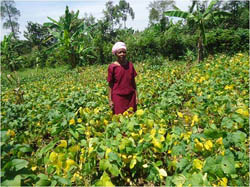Irene Ngochi is a farmer from Emakhunje Village in the densely populated Emukhaya district of Western Kenya. Farm sizes in the district range from as small as 0.05 ha to 1 ha, with the majority (70%) of households owning 0.20 ha. Irene’s household owns an average farm of 0.25 ha. At the age of 50 years, Irene has developed a very positive attitude on planting soybean and climbing beans. "I used to plant soybeans sometime back but I stopped because I did not know how to use it and the yield I got was very small. I did not know that mineral fertilizers would increase yield neither did I know that soybean has so many products and by-products" narrates Irene. It was until the last short rainy season that Irene participated in soybean and climbing bean variety evaluation activities organized by the N2Africa agronomy team. She also attended a training on soybean processing organized by Dr. Josephine Ongoma, the N2 Africa Node leader for the soybean Cluster covering Butere, Mumias, Emukhaya and Khwisero. "I visited the soybean and climbing bean variety trials in Butere and it was so fascinating. The soybeans looked uniform and with many pods. I saw tall beans staked like tomatoes with many pods ten times our normal beans and I decided this is the way to go" smiles Irene.
 |
 |
|
Irene poses for a picture on 0.1 ha plot she hired to grow soybean |
Irene points to climbing bean trailing on one of the trees in her farm |
The variety trials and training on soybean processing motivated Irene to grow climbing beans and soybean and she discussed with her husband who allowed her to use a quarter of their land to grow these crops. She also hired 0.1 ha from the neighbour to grow more soybeans. Irene approached the N2Africa outreach team and managed to convince it to become a satellite farmer. She was given a test pack of 2 kg of soybean seed, 2 kg of Sympal fertilizer and 20 g of BIOFIX inoculants to try on a 20x10 m plot. She also decided to source 0.25 kg of climbing beans and 5 kg soybean seeds from the N2Africa Agronomy team to plant on her extra land. "Because I did not have Sympal and BIOFIX to use on the hired land, I decided to use farm yard manure instead", explains Irene. More interesting was to see how she established climbing beans. Climbing beans were not planted uniformly in the plot but under young trees spread over her farm. The reason she give is lack of staking materials.
Irene reports that she has harvested 370 kg of soybean from her quarter acre and 30 kg of climbing beans. "This yield is extremely high in our village and the whole district, considering the poor fertility of our soils and the legume varities we use" reports Irene. "I plan to sell 250 kg of soybean which will give me at least KSH 12,5000; enough to cover a lot of my family expenses". She says that after learning the processing and utilization of soybeans into different products (like milk, yoghurt, beverage, crunches, chapatti, soycorn blend), soybean now has become an important component of her family’s meals. Irene heads a women self help group with more than 60 members and she has inspired it to grow legumes in an improved way. "We plan to expand the area under soybean and climbing beans, and put legume production on our development agenda. I believe this would be a solution for our small pieces of land" comments Irene with a charming face. She prays that knowledge and equipment on soybean utilization are extended to more farmers, as well as extension services for a wider adoption of legume technologies.
Wycliffe Waswa, John Mukalama and Freddy Baijukya
